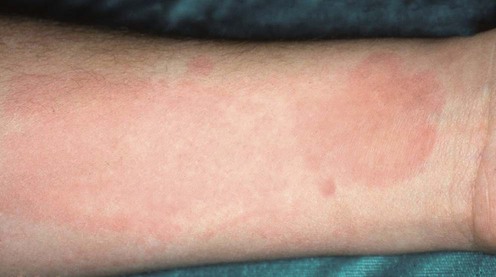About 25% of patients with chronic urticaria have a definable and reproducible physical trigger that distinguishes them from those with spontaneous urticaria and urticarial vasculitis. Physical urticarias are defined by the predominant stimulus that induces them (Table 181.1). More than one physical stimulus elicits urticaria in some patients, and physical urticarias can overlap with spontaneous urticaria. Physical urticarias are included under the term ‘inducible urticarias’ in the latest European classification. Table 181.1 Classification of physical urticarias by the eliciting stimulus (in approximate reducing frequency of occurrence) Non-sedating antihistamines (Table 181.2) should be prescribed in preference to classical antihistamines, which are often sedating and can impair psychomotor performance. Up-dosing of second generation H1 antihistamines is often practiced. Table 181.2 Examples of non- and mildly sedating antihistamines
Physical urticarias, aquagenic pruritus, and cholinergic pruritus

Physical urticarias
Symptomatic dermographism
Stroking or rubbing the skin
Cholinergic urticaria (pale, papular wheals with red flares)
Rise in core temperature and other causes of sweating (exercise, hot baths, spicy food, and stress)
Cold urticaria
Rewarming of skin after cooling (localized or systemic)
Delayed pressure urticaria
Sustained perpendicular pressure
Solar urticaria
Ultraviolet or visible solar radiation
Localized heat urticaria
Local heat contact
Adrenergic urticaria (red papular wheals with surrounding pallor)
Emotional stress
Aquagenic urticaria
Local water contact at any temperature
Exercise-induced anaphylaxis
Exercise, but not hot baths
Food and exercise-induced anaphylaxis
Exercise following a heavy food load or eating specific foods
Vibratory angioedema
Vibration
First-line therapies
Acrivastine
Non-sedating, three-times-daily dosing
Cetirizine
Mildly sedating, once-daily dosing
Levocetirizine
The active enantiomer of cetirizine
Fexofenadine
Non-sedating, once-daily dosing
Loratadine
Non-sedating, once-daily dosing
Desloratadine
The active metabolite of loratadine
Mizolastine
Non-sedating, once-daily dosing
Rupatadine
Non-sedating, once-daily dosing
Second-line therapies
Symptomatic dermographism
Cholinergic urticaria



 Non-sedating (‘second generation’) antihistamines
Non-sedating (‘second generation’) antihistamines H2 receptor antagonists
H2 receptor antagonists Narrowband UVB phototherapy
Narrowband UVB phototherapy Photochemotherapy (PUVA)
Photochemotherapy (PUVA) Omalizumab
Omalizumab Danazol
Danazol Anticholinergics
Anticholinergics Autologous sweat injection
Autologous sweat injection Omalizumab
Omalizumab Cold tolerance (desensitization)
Cold tolerance (desensitization) Leukotriene receptor antagonists
Leukotriene receptor antagonists Antibiotics
Antibiotics Omalizumab
Omalizumab


